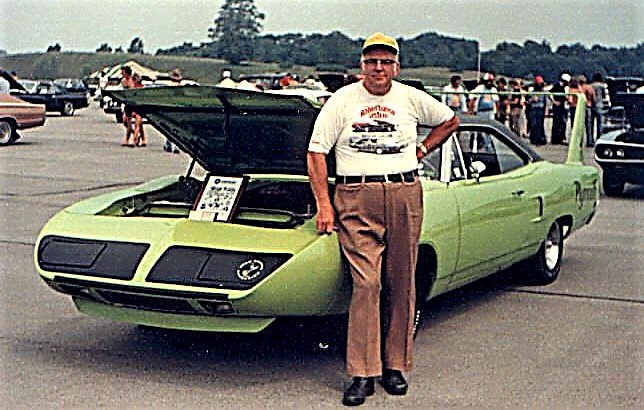
Whether fastback or finback, the aerodynamic racers that roamed the NASCAR oval tracks during the 1969-1970 seasons were some of the most exciting cars ever built.
The buying public did not share the same enthusiasm for the powerful but ungainly cars, however, and the street models required for homologation sat unsold in dealers’ backlots at huge discounts when new. Now, they are amongst the most expensive and prized of all models from the muscle car era.

Ah, to be one of those fortunate few to purchase such a car when they were inexpensive. Even better to own one now as a member of the Daytona/Superbird Auto Club, which not only celebrates the iconic 1969 Dodge Daytona and 1970 Plymouth Superbird, but embraces the rival 1969 Ford Talladega and Mercury Cyclone Spoiler aero cars as well.
Club president Doug Schellinger has hosted his annual summer club picnic for more than 20 years at his home in New Berlin, Wisconsin. This year, the event drew about 35 cars, with a few surprise guests showing up.
The aero cars were slightly modified production models that utilized wind-tunnel testing to maximize their competitive advantage on NASCAR’s super speedways. Ford’s Talladega upped the ante in spring of 1969 with its low frontal-area nose treatment, forcing the competition to come up with a creative answer.
Dodge had a speedway weapon of its own with the Charger 500. While the Charger was a sleek looking car in production form, in the wind-tunnel it was a mess; its flying-buttress C-pillars created too much lift. The solution was a metal plug that filled in the recess and produced a true fastback, resulting in a reshaped rear window and a smaller trunk-lid opening.

John Borucki brought his 440/4-speed Charger 500, one of 392 built that year. His brother purchased the car in the early 1980s, and it’s been in the family ever since. John brought along a newspaper ad from when the Charger was offered on a used-car lot in 1972 for the princely sum of $2,295.
Even when fitted with a flush grill from a 1968 Coronet, the Charger 500 fell short in podium wins against the dominant Fords. Chrysler engineers added a huge downforce wing on the trunk lid, and the finished car became the 1969 Charger Daytona.
The Plymouth Superbird did not come on the scene until 1970. But the end product was not as aerodynamically clean as the Daytona, as concessions to styling were made to sell more of the required homologation street versions.
Doug Schellinger’s dad, Monroe, bought his first street Superbird just before the 1973 fuel crisis, and he founded the club in 1975. Doug recalled in shorthand how his father offered a master’s class in negotiating their first Mopar muscle car purchase.

“So, Dad calls up the kid with the Superbird. Yes, he still has it,” Doug Schellinger related. “Dad doesn’t tell him he’s the same guy who looked at the car (previously). He starts the whole negotiation over. They get to the price, and dad hits him again. The seller more or less opened the door that if ‘you’d come see the car, you’d offer me more. But maybe you wouldn’t.’
“If he hadn’t said the last part, dad would have paid him the (original agreed-upon) $1,800. But he knew the door was open just a little bit. So, he sent his 20-year old son down with $1,600 and an extra $20 in his pocket. Lay the money down and see what happens. Dad went and camped around the block and waited to see what happened.
“About 20 minutes later, the car came wheeling around the corner, and he knew he had bought it.”
Suffice to say, the elder Schellinger turned out to be a shrewd investor when it came to picking appreciating assets, even if he would have given in on that extra 200 bucks.

Another gentleman with long-range investment vision was Neal Bucholtz and his 1968 Roadrunner. Purchased new in late 1968 by 17-year old Bucholtz, the hardtop coupe came special-ordered with the 383/ Hurst 4-speed, Metallic Burgundy paint and deluxe interior. Hanging on to the car for all these years is extra-rewarding for Bucholtz.
“I wish I had a dime for every time I heard some guy at a car show say, ‘I wish I’d kept mine’,” Bucholtz said with a smile. “So how does a 17-year old kid talk his dad into co-signing for a new 1968 Roadrunner? My dad was a very nice guy.”
The picnic always has a few interesting cars that go off-topic. Far from aerodynamic but beautiful in its own right was a 1930 Stutz Model M Speedster owned by Carl and Carrol Jensen. The car had just returned from a special Stutz display at the Indianapolis Motor Speedway Museum held earlier in the year.
Making its barn-find debut was a 1987 Ford Thunderbird NASCAR racer owned by Steve Lueck of Mukwonago, Wisconsin. The car was driven by Blackie Wangerin at Daytona in the late 1980s, then locked in a trailer ever since. Steve bought the whole package and got the engine running; he fired up the stock car to the delight of the party goers.

The elephant-in-the-room for the winged cars was the 1970 Plymouth Superbird No. 7 race car driven by former USAC and NASCAR racer Ramo Stott. The car is powered by a 426 Hemi with a 4-speed, and carries its original sheet metal. Stott drove the car to victory at Daytona in the 1970 ARCA 300.
Now owned by Doug Schellinger, it’s every little boy’s idea of what a rocket car should look and sound like. Although in this case, it just took him a little longer to acquire it.
Photos by William Hall




